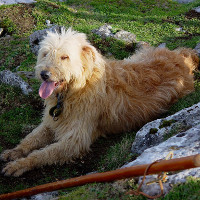Appearance of the Basque Herder
|
| There are two varieties of Basque Herder, the Gorbeiakoa variety and the Iletsua variety. The Basque Herder is a medium-sized dog, weighing on average around 15 kilos and measuring between 46 and 64 centimeters. Basque Herders have a slightly square structure, a chest that is both moderately broad and deep, and strong, straight legs. They tend to have long, broad skulls with fairly long, light muzzles. The Iletsua variety of Basque shepherd tends to grow a little taller and thinner than the Gorbeiakoa variety, with slightly more rectangular heads. Basque shepherds have medium-sized triangular ears that can be erect but often fold forward. Both varieties have black, brown or amber-colored noses and eyes, while the Gorbeiakoa variety has almond-shaped eyes and the Iletsua variety has oval eyes. The Basque Herder Gorbeiakoa has a slightly thick, short to medium coat that generally comes in shades of red, although some are blonder or fawn, while the Basque Herder Iletsua has a slightly longer coat with thicker fur that is generally blonder. or fawn, but can also come in shades of red. |
Temperament of the Basque Herder
|
| Basque Herders are generally very affectionate and open with family members of all ages. They are happiest when physically close to their family. Although they are generally very kind and loving to children and very loyal to all family members, they can sometimes become over-protective and sometimes too quick to smaller children, which can cause rollovers and bumps. They are naturally somewhat territorial and have guard instincts. They can therefore be wary of strangers, but when introduced, they quickly show their friendlier side. Although generally friendly towards humans, Basque Shepherds generally need socialization to get along with other animals. They are intelligent, easy-to-train dogs who are generally eager to please, but can become bored with overly repetitive training sessions. They have a mischievous side and a tendency to test their limits, making innovation and consistency necessary to keep them challenged. |
Needs and activities of the Basque Herder
|
| The Basque Herder is an extremely active dog, with an agile mind and body. These dogs require a lot of exercise and mental stimulation, and can become bored, leading to behavioral problems that can be difficult to eliminate. This breed of dog requires a little space to run around and is not a suitable choice for apartment living. In addition to their obvious talent for breeding, these dogs are well suited to a number of other activities, including agility training, acrobatic canine dance and parkour. Although not particularly well built for swimming, most of these dogs enjoy the water and manage to swim quite effectively. |
Maintenance of the Basque Herder
|
| Although the two types of Basque Herder have very different coats, they tend to have the same grooming requirements. These dogs should only be bathed a few times a year, as too frequent a bath could remove the layer of oil needed to maintain the coat's integrity, and a daily brush stroke is all that's usually needed to remove tangles and debris from their coats. Their coat is quite thick, resistant to dirt. Particular attention should be paid to the Basque Herder's ears, as many of these dogs have hanging ears that can be prone to ear infections. Teeth and nail care should be introduced at an early age, so that your dog can participate in a weekly teeth program and a monthly nail-cutting treatment. |







 English (United Kingdom)
English (United Kingdom)